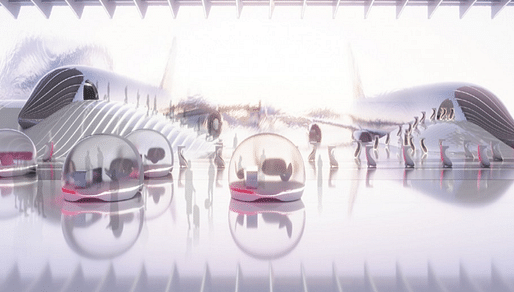
The winners of the 2020 Fentress Global Challenge, an annual global student design competition launched in 2011 by Fentress Architects, have been announced. This year's competition challenge students to reimagine airport mobility in the year 2100. Over 100 projects were submitted. The first-place prize is $15,000, second place $3,000, third place $2,000, and the two People's Choice Awards will receive $1,000.
"A deep passion for design and a creative mindset are the cornerstone of any successful design competition submission,” said Curtis Fentress, FAIA, RIBA, Principal in Charge of Design at Fentress Architects in a statement. “Each year, the submissions we receive are more innovative, spirited and dynamic than the prior year, which shows an exciting outlook for the future of terminal design. We’re greatly impressed by this year’s winners and every submission we received."
Here are this year's winners with captions via the Fentress Global Challenge:
First-Place Winner: BANIYA, The Green Gateway, designed by Nikhil Bang and Kaushal Tatiya from the Southern California Institute of Architecture.
The winning concept, designed by Nikhil Bang and Kaushal Tatiya from the Southern California Institute of Architecture (SCI-Arc), transforms Indira Gandhi International Airport into a forward-thinking, sustainable multimodal hub that mitigates the environmental impacts of air travel while enhancing mobility across New Delhi, India—one of the most populated and polluted cities in the world. The design, dubbed “the Green Gateway,” proposes a future where airports are more than buildings; they provide a seamless connection to the cultural context of the site, from their planning to their form and materiality.

Second-Place Winner: Sejkul, Hartsfield-Jackson Atlanta International Drive-In Airport by Dušan Sekulic, University of Ljubljana, Slovenia.
What does travel and transportation look like in 2100? According to second-place winner Dušan Sekulic—a student at the University of Ljubljana, Slovenia—fully autonomous pods, driving chairs, AI-powered navigation, and vertical take-off and landing (VTOL) aircraft will be key ingredients to designing the next-gen airport experience.
Third-Place Winner: W.A.D, Floating Aero City designed by Yuanxiang Chan, Chaofan Zhang, and Zhuangzhuang King from Beijing Jiaotong University.
This year’s third-place winner responded to an ever-important reality: how airport design can prepare airports located in high-density seaside cities to adapt to the effects of climate change. Floating Aero City, designed by Yuanxiang Chan, Chaofan Zhang, and Zhuangzhuang King from Beijing Jiaotong University, provides a highly visionary approach to sustainable design.
#1 People’s Choice Award Winner: Arch YiYang, The Vertebrae, designed by Yi Yang Chai and Sharon Cho from the University of Malaya.
The biophilic design harmonizes the built environment with nature to create a “garden city”—the future airport archetype that forms a contextual representation of its culture. Located in Singapore, the concept infuses a biophilic and sustainable approach into every element of the design to renvision the airport as a model of sustainability while amplifying the country’s national identity.
#2 People’s Choice Award Winner: RIE, O’Pon the Hill, designed by Ridwan Arifin, Imaduddin Dhia Ul-Fath and Ervin Dwiratno from Yogyakarta University of Technology
The concept blends culture, history and technology to envision the future of O’Hare International Airport. This futuristic terminal features a Smart Air Pad to accommodate vertical take-off and landing. Equipped with nanotechnology, the Smart Air Pad examines the performance of aircraft. Additionally, People Mover Pods move passengers throughout the terminal, enhancing circulation and the overall passenger experience.
No Comments
Block this user
Are you sure you want to block this user and hide all related comments throughout the site?
Archinect
This is your first comment on Archinect. Your comment will be visible once approved.